Coordinate Transformations-Based Antenna Elements Embedded in a Metamaterial Shell with Scanning Capabilities
Abstract
1. Introduction
2. Proposed TO-Based Single Element Cylindrical Beam-Steerer
2.1. Theoretical Model
2.2. Full-Wave Simulation Results
3. Proposed Antenna Array Enclosed by TO-Based Cylindrical Beam-Steerer
Full-Wave Simulations Results
4. Conclusions
Author Contributions
Funding
Data Availability Statement
Conflicts of Interest
References
- Pendry, J.B.; Schurig, D.; Smith, D.R. Controlling Electromagnetic Fields. Science 2006, 312, 1780–1782. [Google Scholar] [CrossRef]
- Leonhardt, U. Optical Conformal Mapping. Science 2006, 312, 1777–1780. [Google Scholar] [CrossRef]
- Post, E.J. Formal Structure of Electromagnetics, 1st ed.; Dover Publications, Inc.: New York, NY, USA, 1962. [Google Scholar]
- Schurig, D.; Mock, J.J.; Justice, B.J.; Cummer, S.A.; Pendry, J.B.; Starr, A.F.; Smith, D.R. Metamaterial electromagnetic cloak at microwave frequencies. Science 2006, 314, 977–980. [Google Scholar] [CrossRef]
- Chen, H.; Luo, X.; Ma, H.; Chan, C.T. The anti-cloak. Opt. Express 2008, 16, 14603–14608. [Google Scholar] [CrossRef]
- Yang, T.; Chen, H.; Luo, X.; Ma, H. Superscatterer: Enhancement of scattering with complementary media. Opt. Express 2008, 16, 18545–18550. [Google Scholar] [CrossRef] [PubMed]
- Rahm, M.; Cummer, S.A.; Schurig, D.; Pendry, J.B.; Smith, D.R. Optical design of reflectionless complex media by finite embedded coordinate transformations. Phys. Rev. Lett. 2008, 100, 063903. [Google Scholar] [CrossRef]
- Yi, J.; Tichit, P.; Burokur, S.N.; de Lustrac, A. Illusion optics: Optically transforming the nature and the location of electromagnetic emissions. J. Appl. Phys. 2015, 117, 084903. [Google Scholar] [CrossRef]
- Tichit, P.; Burokur, S.N.; Lustrac, A.D. Ultradirective antenna via transformation optics. J. Appl. Phys. 2009, 105, 104912. [Google Scholar] [CrossRef]
- Tichit, P.; Burokur, S.N.; Lustrac, A.D. Transformation media producing quasi-perfect isotropic emission. Opt. Express 2011, 19, 20551–20556. [Google Scholar] [CrossRef] [PubMed]
- Kwon, D.H.; Werner, D.H. Transformation optical designs for wave collimators, flat lenses and right-angle bends. New J. Phys. 2008, 10, 115023. [Google Scholar] [CrossRef]
- Wang, M.Y.; Zhang, J.J.; Chen, H.; Luo, Y.; Xi, S.; Ran, L.-X.; Kong, J. Design and Application of a Beam Shifter by Transformation Media. Prog. Electromagn. Res. 2008, 83, 147–155. [Google Scholar] [CrossRef]
- Mitra, D.; Cleveland, J.; Lewis, J.; Braaten, B.D.; Allen, J.; Allen, M. On the use of Multiple Beam-Shifters Developed using Transformation Electromagnetics to Control Propagation Characteristics. In Proceedings of the IEEE Research and Applications of Photonics in Defense Conference (RAPID), Miramar Beach, FL, USA, 10–12 August 2020; pp. 1–2. [Google Scholar]
- Rahm, M.; Roberts, D.A.; Pendry, J.B.; Smith, D.R. Transformation-optical design of adaptive beam bends and beam expanders. Opt. Express 2008, 16, 11555–11567. [Google Scholar] [CrossRef] [PubMed]
- Tichit, P.; Burokur, S.N.; Yi, J.; de Lustrac, A. Transformation Electromagnetics for Antennas with an Illusion on the Radiation Pattern. IEEE Antennas Wirel. Propag. Lett. 2014, 13, 1796–1799. [Google Scholar] [CrossRef]
- Mitra, D.; Roy, P.; Dawn, D. A variable gain CMOS phase shifter for phased array antenna applications. Microw. Opt. Technol. Lett. 2016, 59, 324–328. [Google Scholar] [CrossRef]
- Sanford, J.R. Design of a Miniature Reactive Beam Forming Network. In Proceedings of the 2019 IEEE International Symposium on Antennas and Propagation and USNC-URSI Radio Science Meeting, Atlanta, GA, USA, 7–12 July 2019; pp. 1357–1358. [Google Scholar]
- Yi, J.; Burokur, S.N.; Lustrac, A.D. Experimental validation of a transformation optics based lens for beam steering. Appl. Phys. Lett. 2015, 107, 154101. [Google Scholar] [CrossRef]
- Kundtz, N.; Roberts, D.A.; Allen, J.; Cummer, S.; Smith, D.R. Optical source transformations. Opt. Express 2008, 16, 21215–21222. [Google Scholar] [CrossRef] [PubMed][Green Version]
- Allen, J.; Kundtz, N.; Roberts, D.A.; Cummer, S.A.; Smith, D.R. Electromagnetic source transformations using superellipse equations. Appl. Phys. Lett. 2009, 94, 194101. [Google Scholar] [CrossRef]
- Popa, B.; Allen, J.; Cummer, S.A. Conformal Array Design with Transformation Electromagnetics. Appl. Phys. Lett. 2009, 94, 244102. [Google Scholar] [CrossRef]
- Kwon, D.H. Virtual Circular Array using Material-Embedded Linear Source Distributions. Appl. Phys. Lett. 2009, 95, 173503. [Google Scholar] [CrossRef]
- Deng, L.; Wu, Y.; Hong, W.; Zhu, J.; Peng, B.; Li, S. Conformal Array Design on Arbitrary Polygon Surface with Transformation Optics. AIP Adv. 2016, 6, 065011. [Google Scholar] [CrossRef]
- Chen, H.; Chan, C.T. Transformation media that rotate electromagnetic fields. Appl. Phys. Lett. 2007, 90, 241105. [Google Scholar] [CrossRef]
- Misra, S.; Kalaswad, M.; Zhang, D.; Wang, H. Dynamic tuning of dielectric permittivity in BaTiO3 via electrical biasing. Mater. Res. Lett. 2020, 8, 321–327. [Google Scholar] [CrossRef]
- Stangenberg, R.; Grigoriadis, C.; Butt, H.; Müllen, K.; Floudas, G. Switchable permittivity with temperature and DC-bias in a semifluorinated azobenzene derivative. Colloid Polym. Sci. 2014, 292, 1939–1948. [Google Scholar] [CrossRef]
- Kasirga, T.S.; Ertas, Y.N.; Bayindir, M. Microfluidics for reconfigurable electromagnetic metamaterials. Appl. Phys. Lett. 2009, 95, 214102. [Google Scholar] [CrossRef]
- Agarwal, G.; Ulpenich, A.; Zhu, X.; Möller, M.; Pich, A. Microgel-Based Adaptive Hybrid Capsules with Tunable Shell Permeability. Chem. Mater. 2014, 26, 5882–5891. [Google Scholar] [CrossRef]
- Schurig, D.; Pendry, J.B.; Smith, D.R. Calculation of material properties and ray tracing in transformation media. Opt. Express 2006, 14, 9794–9804. [Google Scholar] [CrossRef] [PubMed]
- Pendry, J.B.; Holden, A.J.; Robbins, D.J.; Stewart, W.J. Magnetism from conductors and enhanced nonlinear phenomena. IEEE Trans. on Microw. Theory Technol. 1999, 47, 2075–2084. [Google Scholar] [CrossRef]
- Kwon, D.H.; Emiroglu, C.D. Low-profile embedded design of endfire scanning arrays with coordinate transformation. J. Appl. Phys. 2010, 107, 034508. [Google Scholar] [CrossRef]
- Yao, P.; Liang, Z.; Jiang, X. Limitation of the electromagnetic cloak with dispersive material. Appl. Phys. Lett. 2008, 92, 031111. [Google Scholar] [CrossRef]
- Hashemi, H.; Qiu, C.-W.; McCauley, A.P.; Joannopoulos, J.D.; Johnson, S.G. Diameter-bandwidth product limitation of isolatedobject cloaking. Phys. Rev. A 2012, 86, 013804. [Google Scholar] [CrossRef]
- Cassier, M.; Milton, G.W. Bounds on Herglotz functions and fundamental limits of broadband passive quasi-static cloaking. J. Math. Phys. 2017, 58, 071504. [Google Scholar] [CrossRef]
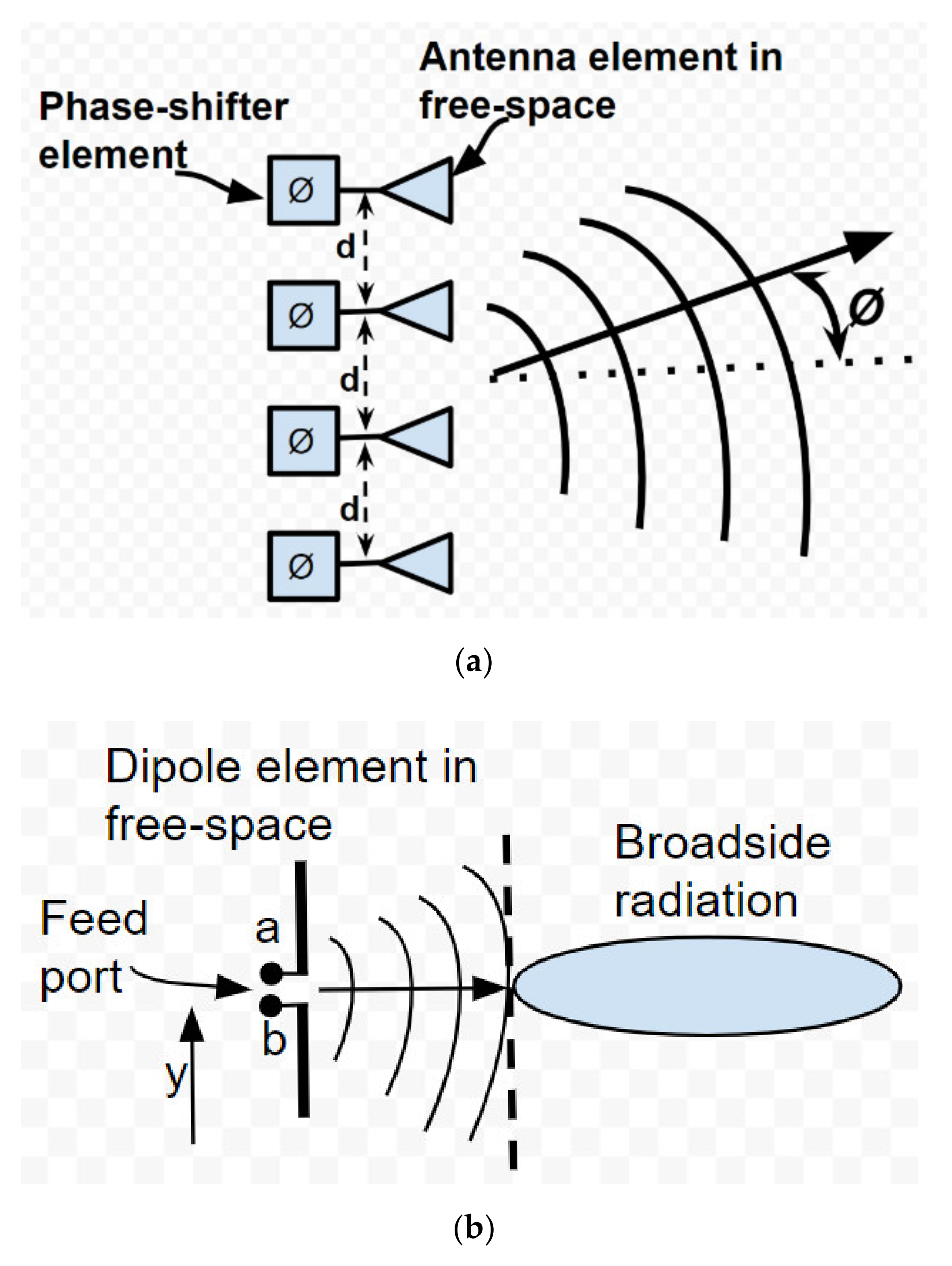
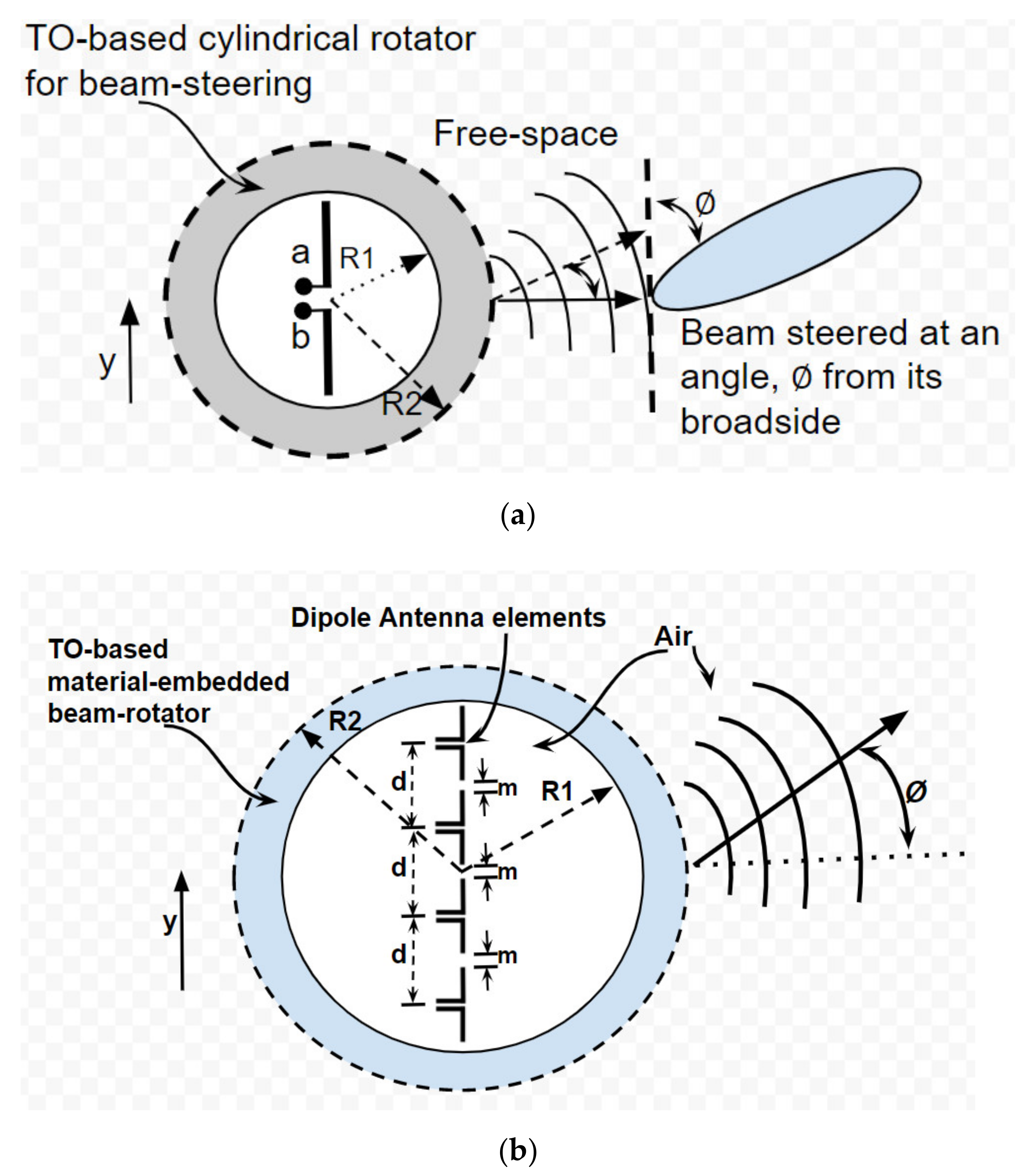
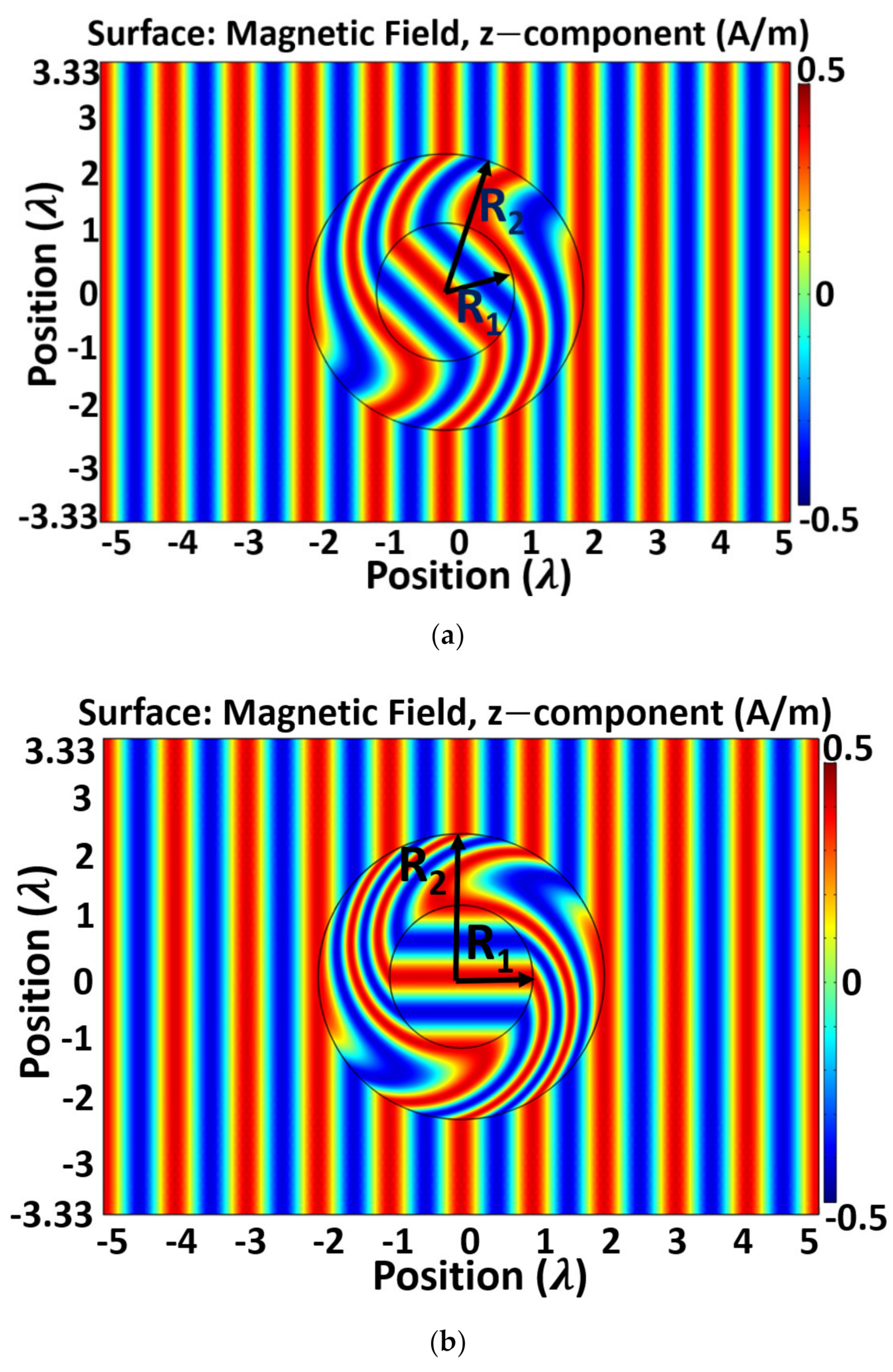

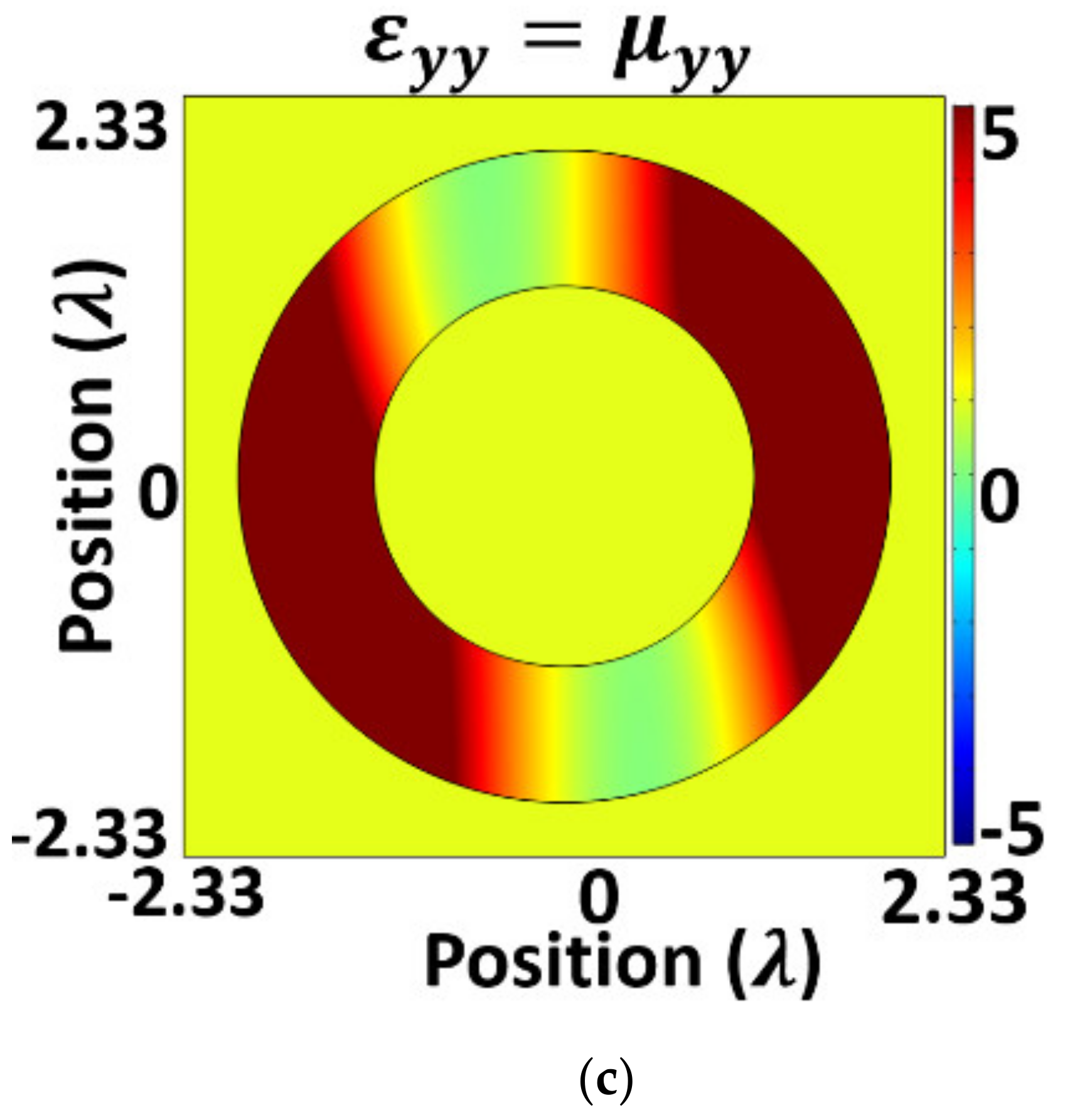
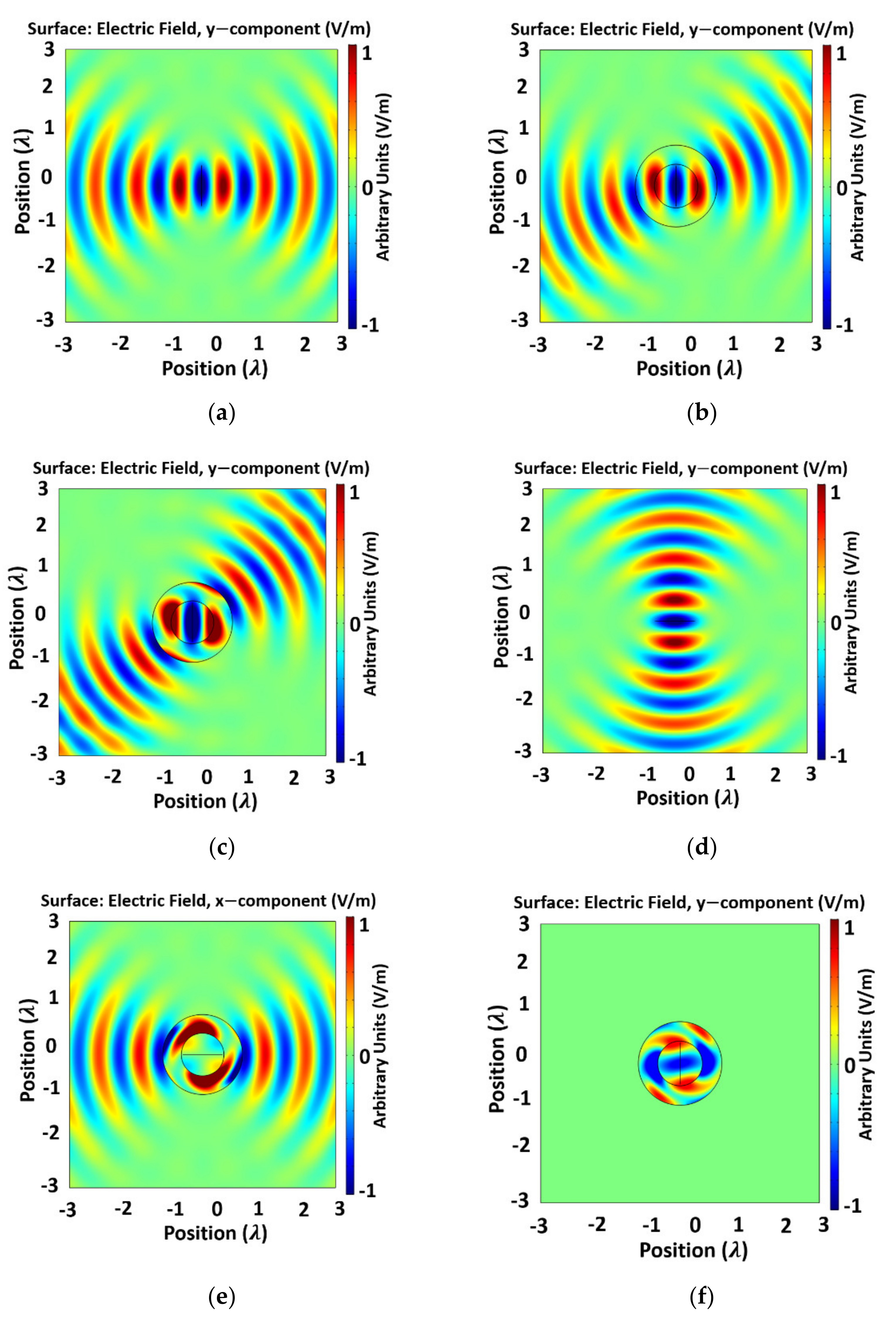


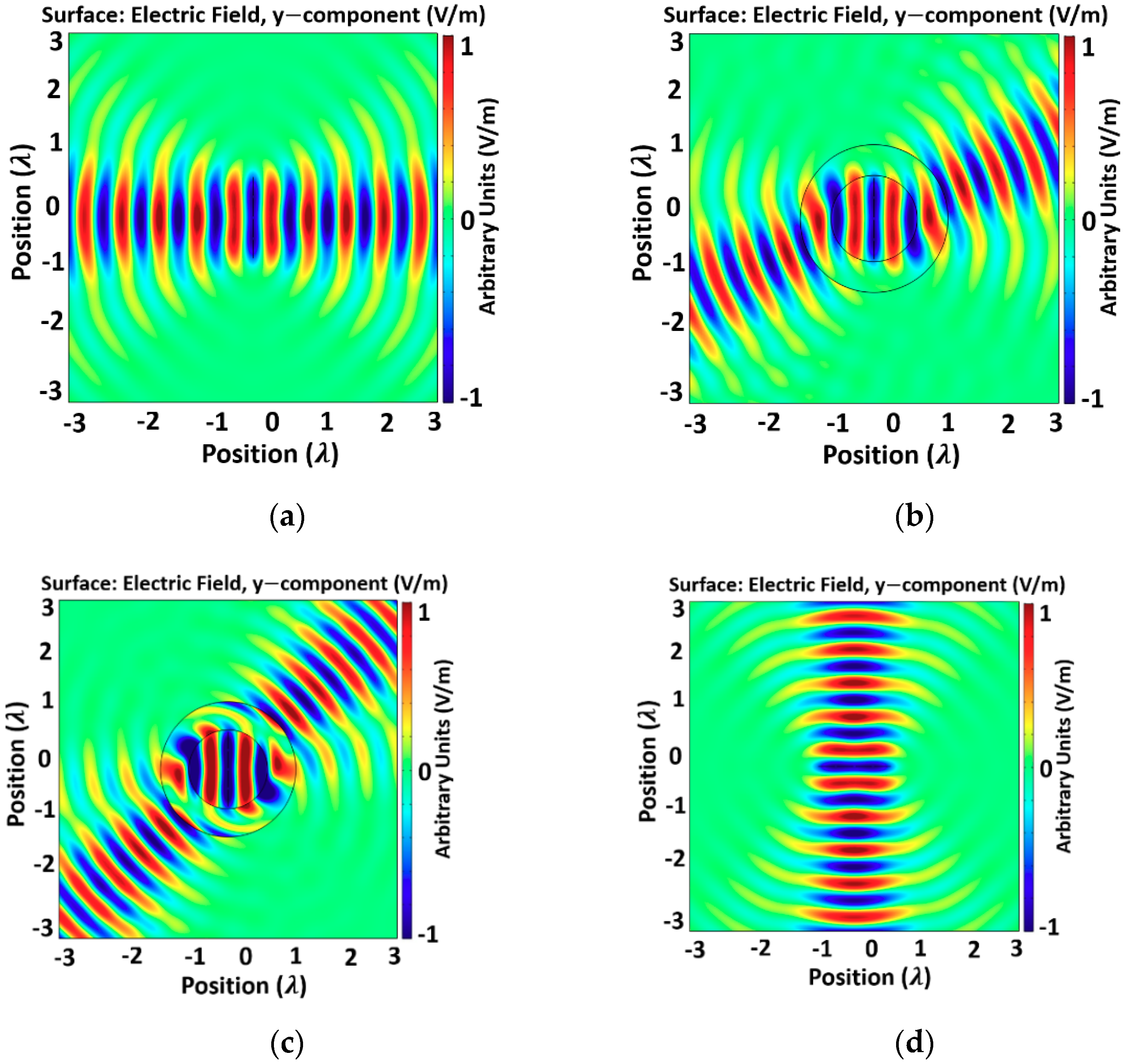
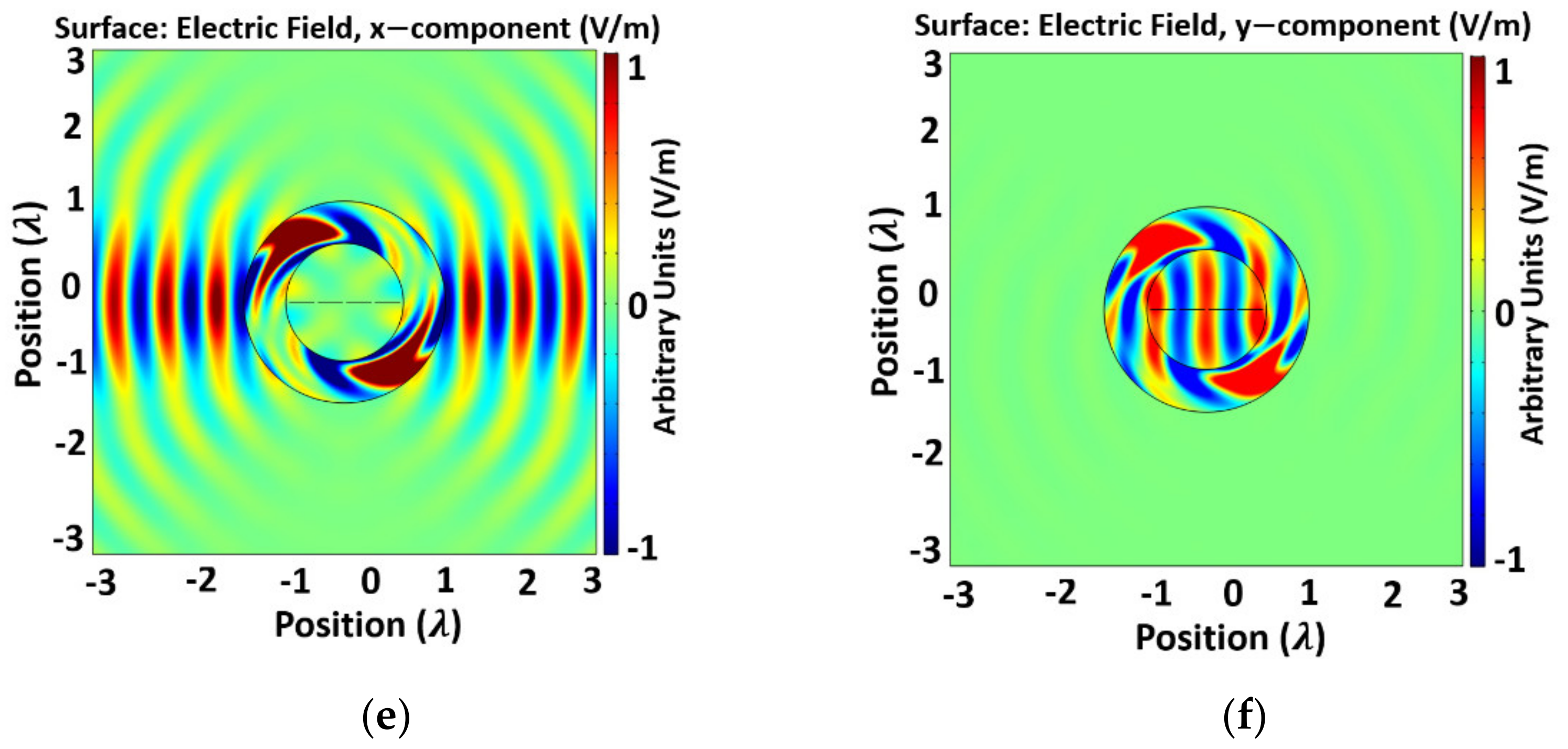
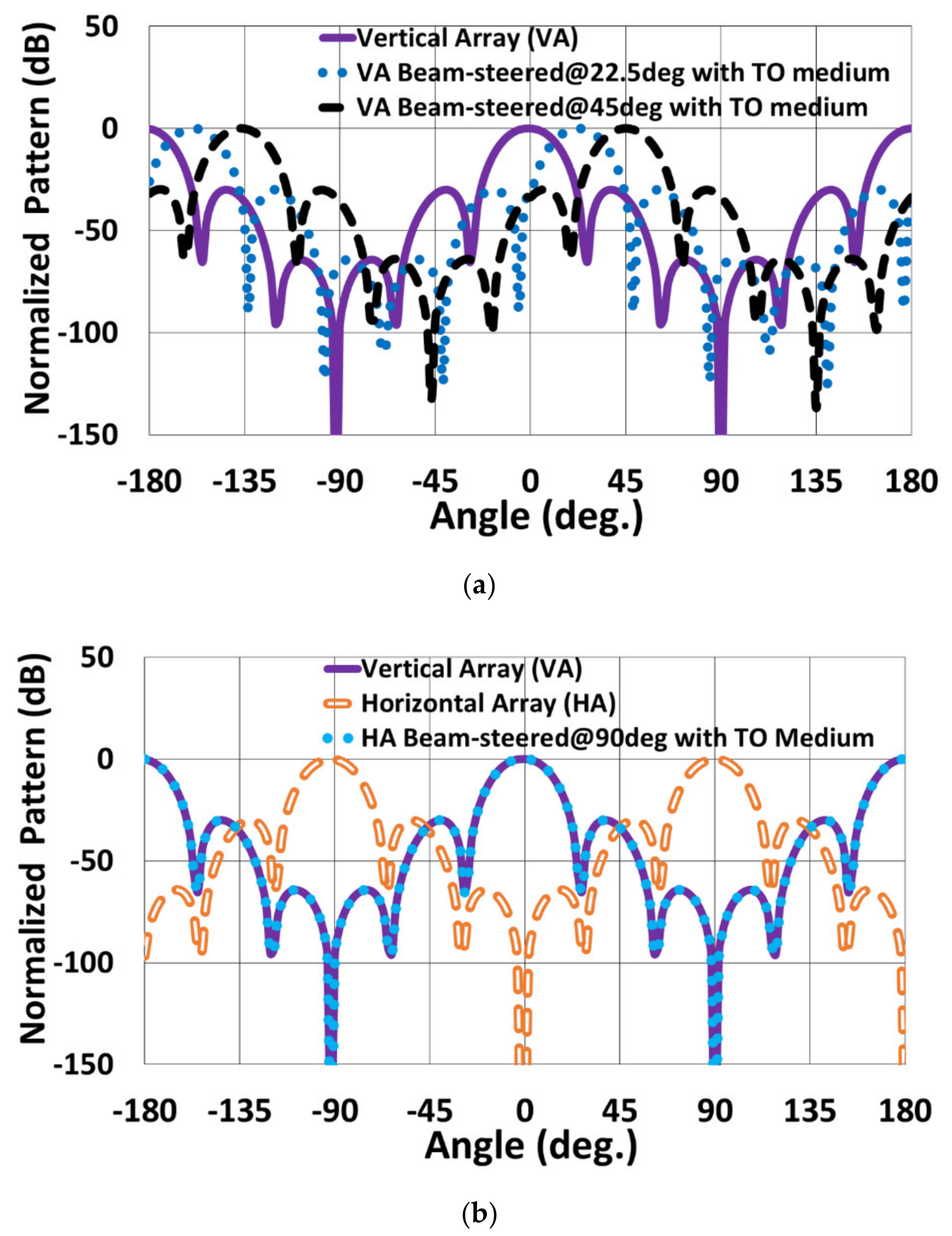

Publisher’s Note: MDPI stays neutral with regard to jurisdictional claims in published maps and institutional affiliations. |
© 2021 by the authors. Licensee MDPI, Basel, Switzerland. This article is an open access article distributed under the terms and conditions of the Creative Commons Attribution (CC BY) license (https://creativecommons.org/licenses/by/4.0/).
Share and Cite
Mitra, D.; Dev, S.; Allen, M.S.; Allen, J.W.; Braaten, B.D. Coordinate Transformations-Based Antenna Elements Embedded in a Metamaterial Shell with Scanning Capabilities. Electronics 2021, 10, 1081. https://doi.org/10.3390/electronics10091081
Mitra D, Dev S, Allen MS, Allen JW, Braaten BD. Coordinate Transformations-Based Antenna Elements Embedded in a Metamaterial Shell with Scanning Capabilities. Electronics. 2021; 10(9):1081. https://doi.org/10.3390/electronics10091081
Chicago/Turabian StyleMitra, Dipankar, Sukrith Dev, Monica S. Allen, Jeffery W. Allen, and Benjamin D. Braaten. 2021. "Coordinate Transformations-Based Antenna Elements Embedded in a Metamaterial Shell with Scanning Capabilities" Electronics 10, no. 9: 1081. https://doi.org/10.3390/electronics10091081
APA StyleMitra, D., Dev, S., Allen, M. S., Allen, J. W., & Braaten, B. D. (2021). Coordinate Transformations-Based Antenna Elements Embedded in a Metamaterial Shell with Scanning Capabilities. Electronics, 10(9), 1081. https://doi.org/10.3390/electronics10091081







